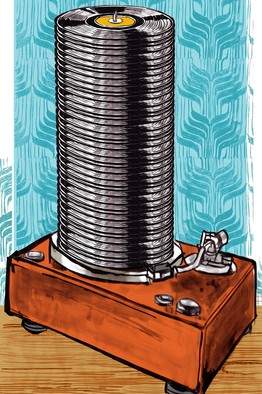(Article from Jan. 27, 2012
Wall Street Journal)
It's Alive! Vinyl Makes a ComebackBy ERIC FELTEN
The digital revolution was supposed to do away with a lot of fusty old relics. First compact discs took their toll on the long-playing (and long-played) vinyl record; then iPods and digital downloads began doing the same to CDs. But long after the eulogies had been delivered, the vinyl LP has been revived.
The LP still represents just a sliver of music sales. But last year, according to Nielsen SoundScan data, while CD sales fell by more than 5%, vinyl record sales grew more than 36%.
The majority of vinyl sells in independent record stores, which have championed the format in their quixotic quest to survive. But now big-box stores such as Best Buy are carrying vinyl. Amazon—loath to let any niche escape its domination—has a "Vinyl Store" and recently introduced shipping boxes designed to coddle LP records in transit.
Not just the sales of records are growing, but the equipment to play them, too. As David Bakula, who follows LPs for Nielsen, puts it: "When I walked into Target and found turntables, then I knew we've arrived."
United Record Pressing, the Nashville factory where the Beatles' first U.S. singles were stamped nearly 50 years ago, is feeling the boom: "This plant often runs 24 hours," says Jay Millar, its marketing director.
Who's buying? Hipster-centric indie genres skew vinyl-heavy—alt rock, garage, punk. The list of last year's best-selling LPs includes discs from the Black Keys, Bon Iver, Fleet Foxes and Radiohead. Classic jazz does pretty well, and then there is classic rock: For several years running, the Beatles' "Abbey Road" (1969) has been the top-selling vinyl LP.
Which is one clue to vinyl's appeal. Yes, "Abbey Road" is an essential recording. But it also features what may be the most recognizable image in rock—the fab (and by then estranged) four scissoring across the street on a bright summer day. Such album artwork just isn't quite the same shrank down for CDs or iPods.
Then there is the sound: Those who collect LPs swear by the virtues of analog. For decades a vinyl-dedicated subset of hard-core audiophiles have resisted the digital onslaught. They've rightly derided the brittle compression of CDs and given the cold shoulder to even the more robust digital formats, such as super-audio CDs. (Don't get them started on the hopeless degradation of MP3s.)
And yet that narrow niche of audiophiles with their Ferrari-dear sound systems isn't what has kept LPs alive. Even, it would seem, in the rarefied world of classical recordings. When the San Francisco Symphony packaged its acclaimed recordings of Gustav Mahler's orchestral works, the set was first made available on SACD. But now it has been released on vinyl as well. According to the symphony's general manager, John Kieser, the idea to release "The Mahler Project" on LPs started a few years ago with his then-teenage son, who collected vinyl and insisted that music sounds different in the old analog format.
Mr. Kieser was also keeping track of the sort of sales statistics Nielsen collects. The symphony released the 22-LP Mahler box in part because "vinyl is the only hard format that has seen any growth." There were 500 boxed sets in the initial run, substantial both in price and heft—$750 and more than 30 pounds. Mr. Kieser says only one or two of the sets are left, a month after the official release.
The Mahler box features heavyweight 180-gram discs. That sort of luxury LP makes up about a quarter of the vinyl market. "It's like picking up a toaster from the '50s," says Mr. Millar of United Record Pressing. "You feel like you've got something substantial."
Substantial. That's the word I keep hearing from the fans of vinyl. Records are admirably physical, the antithesis of the everywhere-and-nowhere airiness of "the cloud."
The embrace of vinyl isn't just some retro fad, but a push-back against the techno-triumphalism that insists there is no future for physical artifacts like books and newspapers. It's a small declaration of independence, a refusal to let the march of progress stomp on one's pleasures.
Vinyl is an assertion that efficiency isn't everything. Cars may have done in the buggy, but there still are people who like horses. Engines on watercraft have long obviated the need to mess about with furling and unfurling canvas, luffing and gybing and all the other soggy inconveniences. And yet there are those who choose sailboats. Who needs wine corks when bottle-caps do the job?
Vinyl is decidedly inconvenient, which is the very reason it appeals. To play records, you have to be relatively engaged in the activity. The disc has to be taken off the shelf and out of its sleeve. It has to be placed on the platter. The needle has to be lowered just so. How different that is from the way we've been encouraged to consume music—as a sort of automated aural wallpaper best achieved by a digital playlist in shuffle mode. Vinyl demands—and encourages—more attention. "If I'm cooking or cleaning around the house, I'll plug in the iPhone or play CDs," says Nick Blandford, managing director of the Jagjaguwar record label, home to the indie-folk-rock band Bon Iver. "But if I'm sitting down deliberately to listen to music, I'll listen to vinyl."